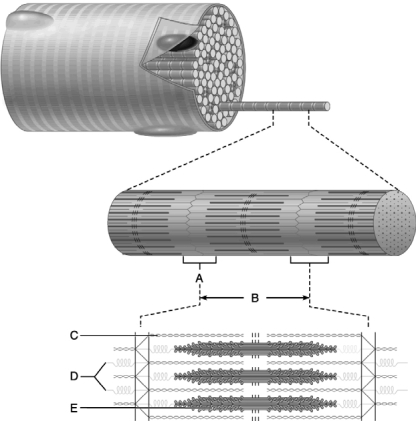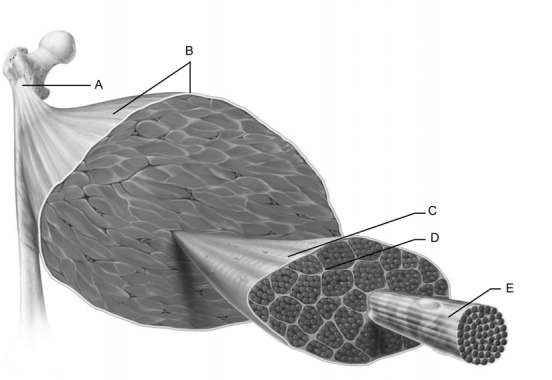A) fast oxidative fibers can convert to fast glycolytic fibers.
B) slow oxidative fibers can convert to fast oxidative fibers.
C) slow oxidative fibers can convert to fast glycolytic fibers.
D) fast glycolytic fibers can convert to fast oxidative fibers.
F) B) and C)
Correct Answer

verified
Correct Answer
verified
Short Answer
Muscles in the appendages typically have their origins to the insertion.
Correct Answer

verified
Correct Answer
verified
Multiple Choice
Which statement about muscle attachments is false?
A) At least one joint is present between an origin and insertion.
B) Insertions are usually distal to the origin.
C) An insertion can be at either attachment point of a muscle, depending on body position and the movement being performed.
D) Upon contraction, the origin is pulled toward the insertion.
F) All of the above
Correct Answer

verified
Correct Answer
verified
Multiple Choice
The characteristic of muscle tissue that results more from its connective tissue components than from its muscle cells is
A) elasticity.
B) contractility.
C) excitability.
D) extensibility.
F) B) and C)
Correct Answer

verified
Correct Answer
verified
Multiple Choice
Titin
A) prevents a muscle from being overstretched.
B) connects myosin to actin.
C) forms the Z disk to which actin attaches.
D) limits the degree to which a muscle may contract.
F) All of the above
Correct Answer

verified
Correct Answer
verified
True/False
Fibromyalgia is a muscular disease, and its cause is known to be genetic.
B) False
Correct Answer

verified
Correct Answer
verified
Multiple Choice
In striated muscle, the I band is where
A) thin filaments occur.
B) H zones occur.
C) only thick filaments occur.
D) thick and thin filaments occur.
F) A) and C)
Correct Answer

verified
Correct Answer
verified
Multiple Choice
In limbs, the insertions of muscles almost always lie to their origins.
A) posterior
B) lateral
C) distal
D) proximal
F) A) and B)
Correct Answer

verified
Correct Answer
verified
Multiple Choice
 Figure 10.2
Use the diagram above to answer the following questions.
-Identify the letter that indicates the I band.
Figure 10.2
Use the diagram above to answer the following questions.
-Identify the letter that indicates the I band.
A) A
B) B
C) C
D) D
E) E
G) None of the above
Correct Answer

verified
Correct Answer
verified
Multiple Choice
 Figure 10.1
Use the diagram above to answer the following questions.
-Identify the letter that indicates the endomysium.
Figure 10.1
Use the diagram above to answer the following questions.
-Identify the letter that indicates the endomysium.
A) A
B) B
C) C
D) D
E) E
G) All of the above
Correct Answer

verified
Correct Answer
verified
Multiple Choice
This type of muscle includes the fast oxidative fibers.
A) skeletal muscle
B) smooth muscle
C) cardiac muscle
E) A) and C)
Correct Answer

verified
Correct Answer
verified
Multiple Choice
 Figure 10.2
Use the diagram above to answer the following questions.
-This structure is the basic unit of contraction.
Figure 10.2
Use the diagram above to answer the following questions.
-This structure is the basic unit of contraction.
A) A
B) B
C) C
D) D
E) E
G) B) and E)
Correct Answer

verified
Correct Answer
verified
Multiple Choice
A cell of this type of muscle is striated and can be uninucleated or binucleated.
A) skeletal muscle
B) smooth muscle
C) cardiac muscle
E) A) and C)
Correct Answer

verified
Correct Answer
verified
Multiple Choice
As skeletal muscles enlarge in a weight lifter, all of the following occur except
A) myofibrils become more abundant in the muscle cells.
B) muscle cells grow larger.
C) muscle cells divide mitotically.
D) myofilaments become more abundant in the muscle cells.
F) C) and D)
Correct Answer

verified
Correct Answer
verified
Multiple Choice
This type of muscle, along with cardiac muscle, is called visceral muscle.
A) skeletal muscle
B) smooth muscle
C) cardiac muscle
E) A) and C)
Correct Answer

verified
Correct Answer
verified
Multiple Choice
This type of muscle may be affected by rhabdomyolysis.
A) skeletal muscle
B) smooth muscle
C) cardiac muscle
E) None of the above
Correct Answer

verified
Correct Answer
verified
Multiple Choice
A muscle fascicle is
A) a single muscle cell.
B) a tendon.
C) a bundle of myofilaments.
D) a bundle of cells.
F) B) and C)
Correct Answer

verified
Correct Answer
verified
True/False
Contraction of a muscle cell requires the influx of calcium into the sarcoplasm.
B) False
Correct Answer

verified
Correct Answer
verified
Multiple Choice
 Figure 10.1
Use the diagram above to answer the following questions.
-This structure is composed entirely of dense regular connective tissue and connects bone to muscle.
Figure 10.1
Use the diagram above to answer the following questions.
-This structure is composed entirely of dense regular connective tissue and connects bone to muscle.
A) A
B) B
C) C
D) D
E) E
G) A) and D)
Correct Answer

verified
Correct Answer
verified
Multiple Choice
Visceral muscle refers to
A) smooth muscle only.
B) cardiac muscle and smooth muscle.
C) skeletal muscle and cardiac muscle.
D) skeletal muscle and smooth muscle.
F) A) and C)
Correct Answer

verified
Correct Answer
verified
Showing 61 - 80 of 110
Related Exams